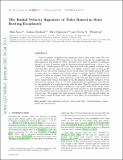The radial velocity signature of tides raised in stars hosting exoplanets
Author(s)
Arras, Phil; Burkart, Joshua; Quataert, Eliot; Weinberg, Nevin N.
DownloadWeinberg_The radical.pdf (188.5Kb)
OPEN_ACCESS_POLICY
Open Access Policy
Creative Commons Attribution-Noncommercial-Share Alike
Terms of use
Metadata
Show full item recordAbstract
Close-in, massive exoplanets raise significant tides in their stellar hosts. We compute the radial velocity (RV) signal due to this fluid motion in the equilibrium tide approximation. The predicted RVs in the observed sample of exoplanets exceed 1 m s[superscript −1] for 17 systems, with the largest predicted signal being ∼30 m s[superscript −1] for WASP-18 b. Tidally induced RVs are thus detectable with present methods. Both the tidal fluid flow and the epicyclic motion of a slightly eccentric orbit produce an RV signal at twice the orbital frequency. If care is not taken, the tidally induced RV may, in some cases, be confused with a finite orbital eccentricity. Indeed, WASP-18 b is reported to have an eccentric orbit with small e= 0.009 and pericentre longitude w = -π/2. Whereas such a close alignment of the orbit and line of sight to the observer requires fine-tuning, this phase in the RV signal is naturally explained by the tidal velocity signature of an e= 0 orbit. Additionally, the equilibrium tide estimate for the amplitude is in rough agreement with the data. Thus, the reported eccentricity for WASP-18 b is instead likely a signature of the tidally induced RV in the stellar host. Measurement of both the orbital and tidal velocities for non-transiting planets may allow planet mass and inclination to be separately determined solely from RV data. We suggest that high-precision fitting of RV data should include the tidal velocity signal in those cases where it may affect the determination of orbital parameters.
Date issued
2012-05Department
Massachusetts Institute of Technology. Department of PhysicsJournal
Monthly Notices of the Royal Astronomical Society
Publisher
Oxford University Press
Citation
Arras, Phil, Joshua Burkart, Eliot Quataert, and Nevin N. Weinberg. “The radial velocity signature of tides raised in stars hosting exoplanets.” Monthly Notices of the Royal Astronomical Society 422, no. 2 (May 11, 2012): 1761-1766.
Version: Original manuscript
ISSN
00358711
1365-2966